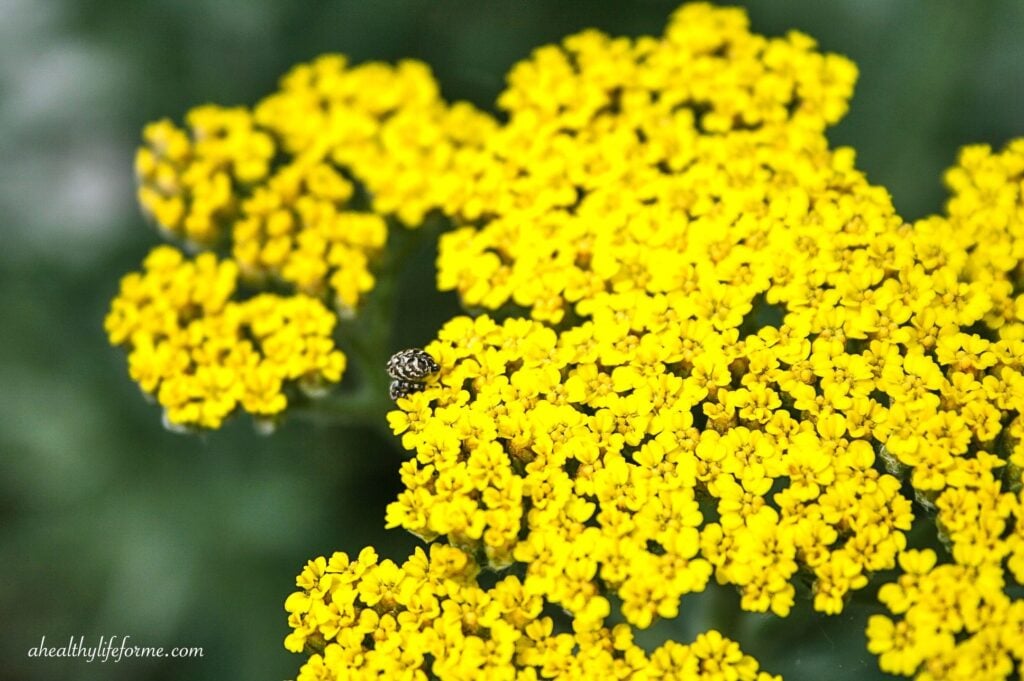How to Grow and Care for Yarrow a versatile and stunning perennial herb. Everyday when I walk past the beauty of Yarrow, I marvel at its vibrant yellow color, it looks like its glowing. Its name ‘Moonshine’ is very fitting.
There are 100 or so species of Yarrow or formally known as Achillea millefolium, ranging in almost in color you could want.
Common yarrow is a cosmopolitan weed originally native to Europe and western Asia. Today it grows in temperate regions worldwide. In the U.S. it occurs in disturbed areas, road shoulders, meadows and fields from Texas to Florida and north to southern Canada.
In Europe, yarrow is seldom allowed near respectable gardens. Oh, but not here in North America, we love it!
Yarrow is a very non-demanding plant growing in almost any soil condition as long as it is in full sun. Though well drained soil will give you more blooms.
Bloom time varies by cultivar, anytime between spring to fall. Deadheading flowers will encourage a second bloom and who wouldn’t want to see a reappearance of this beauty in their garden! If it is happy where it grows you will need to divide it every couple of years to extend its life.
If you look past its pretty face it is a very diverse plant. It is a Herb with many medicinal properties, even though most of us grow it for its beautiful flowers, which make excellent fresh or dried arrangements. If you want to dry the flowers and keep their color you must dry them in silica gel.
In Greek mythology, the centaur Chiron, conveyed herbal secrets to his human pupils. One of these pupils was Achilles who is said to have used it to stop bleeding wounds of his soldiers. You have probably noticed the genus Achillea was derived from Achilles. Yarrow was also used in the U.S. Civil War and was known as soldier’s woundwort.
Several Native American tribes used (and probably continue to use) common yarrow for medicinal purposes. The Pawnee used the stalk for pain relief. The Chippewa used the leaves for headaches by inhaling it in a steam. They also chewed the roots and applied the saliva to their appendages as a stimulant. The Cherokee drank a tea of common yarrow to reduce fever and aid in restful sleep. The Navajo chewed it for toothaches and used an infusion to treat earaches.
Vibrant colors, Medicinal properties, dried flowers for arrangements this beautiful flower can do it all!
Say, have you seen my Sandy fair,
Ye shepherds tell me true?
Last night he left me in despair,
And, sighing, cried adieu.
O where can he stray, the bonny boy,
Return my winsome marrow,
And fill this aching heart wi’ joy,
Thou sweetest flow’r of Yarrow.
Oft by pale moonlight thro’ the mead
We two did kindly stray;
Then sweetly on his oaten reed
He pip’d so blythe and gay;
And oft beneath the shady tree
He ca’d me his bonny marrow,
And vow’d he’d aye be true to me,
The sweetest flow’r of Yarrow.
Adieu, ye nymphs and woodland swains,
Each valley, dell, and grove,
Ye verdant meads and flow’ry plains,
Where we were wont to rove:
This doleful tale some pensive maid
May tell wi’ mickle sorrow,
How Mary in the dust is laid,
For the sweetest flow’r of Yarrow.














Isn’t it funny that one person’s weed is another person’s wonder? I, too, love yarrow, and ours is about to start blooming… Yours looks especially beautiful next to that fence!
It is amazing how us gardeners take a wildflower, tame it, somewhat and make it thrive in our gardens!